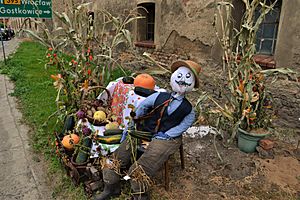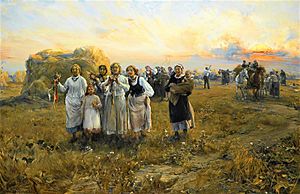Dożynki facts for kids
Quick facts for kids Dozhynki |
|
|---|---|

Last sheaf. Russia. Photos of the early 20th century
|
|
| Also called | Russian: Обжинки, romanized: Obzhynki; Polish: Obrzynki; Belarusian: Прачыстая, Prachystaya; Czech: Dožínky; Kashubian: Òżniwinë; Dormition |
| Observed by | Slavic people |
| Significance | The end of the harvest crops |
| Date | Varies by region; August 15 (28); in Poland: 23 September; In some regions of Russia: September 8 (21) or September 14 (27). |
Dozhynki (pronounced Doe-ZHIN-kee) is a special harvest festival celebrated by Slavic people. It marks the end of the busy harvest season. In the past, this festival often happened around the autumn equinox (around September 23rd). Today, it is usually celebrated on a Sunday after all the crops have been gathered. The exact date can be different in various parts of Europe.
This festival began long ago, even before Christianity became common. It was linked to ancient Slavic beliefs about plants, trees, and farming. By the 16th century, in Central and Eastern Europe, Dozhynki started to include Christian traditions. Wealthy landowners and farmers would organize it to thank the workers and their families for their hard work during the harvest and the whole year.
Even though there are many different ways to celebrate Dozhynki, some things are almost always the same. Farmers often gather in their fields outside the village. They form a parade and bring back a sheaf of grain. This is usually the very last bit of cereal harvested from the fields. Women then turn this grain into a beautiful wreath. They offer it to a special guest, like the person who organized the celebration. This could be a local leader or the richest farmer.
Contents
What Dozhynki Means
The word "Dozhynki" has many different names depending on where you are. In Poland, it's mostly called dożynki. But you might also hear wyżynki, obrzynki, wieniec, wieńcowe, żniwniok, or okrężne. In Belarus, some names include Feast of the Most Clean One, Aspazha, Haspazha, Great Spazha, Zelnya, Talaka, and Dazhynki. Sometimes, it's also called Green Feast or Dormition. This is because it often mixes with the Christian holiday of the Assumption of Mary.
How Dozhynki Started
It's hard to know exactly how Slavic harvest festivals began. This is because there are not many old writings from before Christianity. But we do know that people in northern Slavic lands, like Poland and Russia, were mostly farmers. They worshipped gods linked to farming and the changing seasons.
For example, an ancient Slavic tribe called the Rani would gather every year. They met at a temple in Arkona after the harvest. They would offer a huge, human-sized pancake to their god, Svetovid. This pancake was made from the fresh grain. If the priest could hide behind it, people believed the next year's harvest would be just as good. People also thought that a wreath made from the last straws of grain had special powers.
Main Traditions of Dozhynki
A very important part of Dozhynki is the wreath. It stands for a great harvest and good luck. It also shows the power of new life in the grain. This is why in many areas, grain from the wreath is used for the first seeds planted next year. For example, this happens in the Holy Cross Mountains in Poland.
Originally, the wreath was a decorated sheaf of grain. It was decorated with wildflowers, ribbons, and braided straws. Even in the 1930s, people in Poland still made these kinds of wreaths. Over time, other shapes became popular. Now, you often see round wreaths, but crown-shaped, oval, or rectangular ones are also common.
The sheaf or wreath is usually carried back to the village in a special parade. It is often blessed. Sometimes, a Christian priest blesses it with holy water. In other places, the priest comes to where the celebration is happening.
When Dozhynki is Celebrated
The old pagan festival was held on the autumn equinox (September 23rd). But over time, the celebration became more about when the actual farming work ended in each area. The time between the end of harvest and the festival can be different. For example, near Kielce and Kraków in Poland, the wreath was traditionally blessed on August 15th. It was then kept for a night or two before the grain was threshed and planted right away.
Dozhynki in Poland
In Poland, Dozhynki is still a very important farming holiday. It's a time to celebrate the hard work of farmers all year. It has been celebrated since the Middle Ages. Many different ways of celebrating have existed in Poland. But three things were always there:
- Cutting the last ears of grain.
- Making a wreath.
- Marching with the wreath to a farm house or manor.
- Finally, a big feast with traditional dances.
After 1945, during the time of the Polish People's Republic, Dozhynki became more political. The government used it to show the strength of workers and farmers. But traditional customs were still a big part of the celebrations. In the 1990s, after the fall of the Soviet Union, the festival went back to its more religious meaning. It also kept its folk traditions.
Today, Poland has a national "Presidential Harvest Festival." This was started in 1927 by President Ignacy Mościcki. Modern Dozhynki celebrations can be religious or not. But they always include old customs for the end of the harvest. If it's a religious festival, people usually thank the Christian God and the Mother of God for the crops. However, some groups in Poland who follow old Slavic beliefs still honor ancient Slavic gods during Dozhynki.
Dozhynki in Russia
In Russia, Dozhynki is part of the traditional calendar of Eastern Slavs. It marks the end of the harvest. In many places, it falls on August 15th (or 28th by the old calendar). In other places, it's celebrated in September. The holiday gets its name because the grain harvest usually finishes by mid-August. The celebration includes special traditions with the last sheaf of grain. It also includes a ritual called "curling beard" and a festive meal.
This tradition was almost lost in Russia during the Soviet period. But after the Soviet Union ended, this folk tradition has been brought back in some countries as an official holiday.
Images for kids




